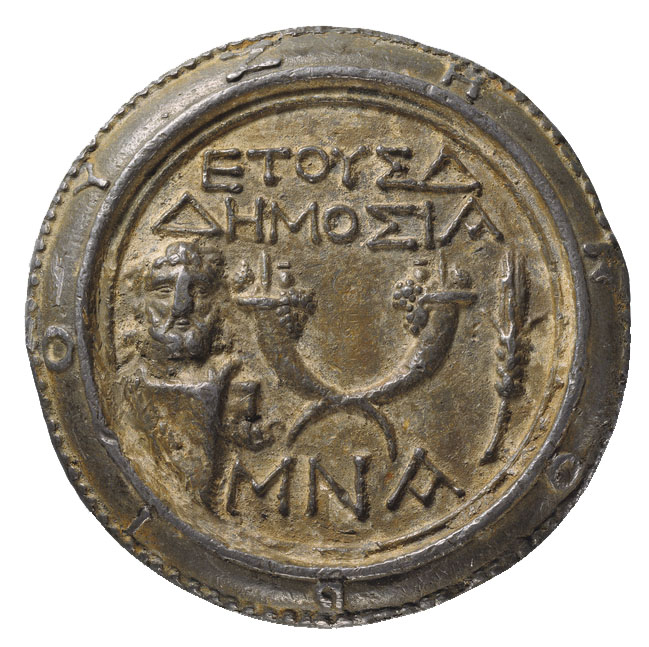
-
Copyright credit: J. Paul Getty Museum

-
Copyright credit: True and Hamma 1994

-
Copyright credit: Collector’s Journal of Ancient Art 1987

-
Copyright credit: Collector’s Journal of Ancient Art 1987

ARCHAEOLOGICAL DESCRIPTION OF THE WEIGHT
Authority
Zenobios, agoranomos (Seleucia Pieria)
Mint
Seleucia Pieria
Denomination
1 Mina
Material
Lead
Manufacture
Cast
Shape
Disc or similar (ellipse, etc.)
Length
12.07 cm
(4.75 inch)
Width
12.07 cm
(4.75 inch)
Height
0.95 cm
(0.375 inch)
Metrology
| Mass (g) | Mass (grain) | Date of measurement | Reference | fragmented | cleaned | reference weight |
|---|---|---|---|---|---|---|
| 885.00 | 13657.7018 | - | www.getty.edu | No | No | Yes |
Iconography
| Symbol | Technique | Direction | Position | Number | Synecdoche |
|---|---|---|---|---|---|
| Herm | Relief | ||||
| Ear of wheat | Relief | ||||
| Double cornucopia | Relief |
Wear
Corrosion
Handle
No
Suspension hole
No
Recarved mould
No
Recarved weight
No
Intentionally destroyed
No
Archaeological description
Collector’s Journal of Ancient Art 1987: Greek Imperial Weight, Syria. Palmyra, c. 270 AD. A lead mina weight, with crossed cornucopiae, a bearded Herm, date palm, ΕΤΟΥΣΑ/ΔΗΜΟΣΙΑ above, ΜΝΑ below. Around the
edge ΖΗΝΟΒΙΟΥ. This marvelously well-preserved weight was issued under the administration of Queen Zenobia. D: 12 cm; Wt: 2 lbs. avoir. Unique.
Getty Museum: The Greek inscriptions on this circular weight read “Of Zenobios; year 4; public; mina.” They identify the weight as having been an official public standard against which other weights were checked. Zenobios would have been the current agoranomos, the government official in charge of the accuracy of weights and measures used in the markets. The mina was a basic unit of measure in the eastern Mediterranean well into the Roman period. The symbols interspersed among the inscriptions relate to the economic well-being of the city that issued the weight. At the left is a herm depicting a bearded god, perhaps Hermes in his role as god of the marketplace. Two cornucopiae, or horns of plenty, symbolize prosperity and abundance, as does the shaft of wheat at the right. The raised rings on the back may have been used to calibrate the weight.
edge ΖΗΝΟΒΙΟΥ. This marvelously well-preserved weight was issued under the administration of Queen Zenobia. D: 12 cm; Wt: 2 lbs. avoir. Unique.
Getty Museum: The Greek inscriptions on this circular weight read “Of Zenobios; year 4; public; mina.” They identify the weight as having been an official public standard against which other weights were checked. Zenobios would have been the current agoranomos, the government official in charge of the accuracy of weights and measures used in the markets. The mina was a basic unit of measure in the eastern Mediterranean well into the Roman period. The symbols interspersed among the inscriptions relate to the economic well-being of the city that issued the weight. At the left is a herm depicting a bearded god, perhaps Hermes in his role as god of the marketplace. Two cornucopiae, or horns of plenty, symbolize prosperity and abundance, as does the shaft of wheat at the right. The raised rings on the back may have been used to calibrate the weight.
Autopsy
No
INSCRIPTION
| Language | Technique | Legend type |
|---|---|---|
| Greek | Relief | Authority, Date, Denomination, Mint |
Fac simile
Edition
Ἔτους δ´ | δημοσία | μνᾶ. || Ζηνοβίου.
Monogram
ARCHAEOLOGICAL CONTEXT
Findspot (region)
Findspot (site)
context
CIRCUMSTANCES OF ACQUISITION
Region
City
Date of first acquisition
circumstances
Gift of Barbara and Lawrence Fleischman (New York, 1925 - New York, 1997) to the J. Paul Getty Museum in 1996. Sold to Barbara and Lawrence Fleischman in 1990, Fritz Bürki & Son (Zurich, Switzerland). Sold to Fritz Burki & Son in Antiquities, Hesperia Arts Auction, Ltd., New York, November 27, 1990, lot 41, from a Private Collection.
[This weight is not the one that was sold in Auction Hirsch 1909, no. 3444.]
[This weight is not the one that was sold in Auction Hirsch 1909, no. 3444.]
DATING OF THE WEIGHT
Curatorial Section
GREEK
Time frame
FROM
-106
TO
-105
Comments on Chronology
Year 4 of Seleuceia: 106/105 BCE (Gatier 1991)
COLLECTION HISTORY
Collection
| Name | Date of acquisition | Inventory number |
|---|---|---|
| Bürki Collection | Nov. 27, 1990 | None |
| Fleischman Collection | Dec. 31, 1990 | F250 |
| Getty Museum – Getty Villa (Malibu) | Dec. 31, 1996 | 96.AI.198 |
Bibliography
| Reference | Page/Column | Reference (number) | Plate / Figure | Comment |
|---|---|---|---|---|
| CJA 1987 | 1, 20 | None | fig | None |
| Auction Hesperia 1990 | 41 | (non vidi) | ||
| Gatier 1991 | None | None | None | None |
| True and Hamma 1994 | 307-308 | 160 | ||
| Bodel and Tracy 1997 | 11 | (non vidi) | ||
| Getty Museum 1997–98 | 69 | |||
| BÉ 2006 | 727 | 448 | None | None |
VARIA
Additional comment
Permalink